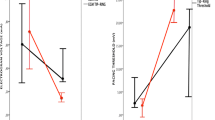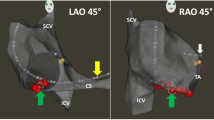Abstract
Purpose
Eight-millimeter-tip ablation catheters are characterized by poor mapping resolution as they depend on electrode size and spacing. IntellaTip MiFi XP 8-mm (Boston Scientific) catheters offer high mapping resolution due to 3 mini-electrodes (ME) located at the distal tip of the catheter and are dedicated for cavo-tricuspid isthmus (CTI) radiofrequency ablation (RFA). The aim of the study was to evaluate the usefulness, effectiveness and safety of novel IntellaTip MiFi XP catheter for CTI RFA and its ability to localize anatomical structures of the heart.
Methods
The study included 10 patients referred for atrial flutter ablation. The 3D mapping system EnSite Velocity was utilized for catheter visualization. The ME signals were used for tricuspid annulus visualization, RF delivery effectiveness assessment defined as ME signal attenuation, and localization of the gaps in the ablation line. The use of ME signals for TV annulus localization resulted in a 13.9 mm (35.5 ± 4.8 mm vs 49.4 ± 7.8 mm; p < 0.01) shorter ablation line in comparison with the potential ablation line designed using standard bipol. The ablation endpoint, bidirectional block, was achieved in all 10 cases (100%) and lasted for at least 15 min after the last RF delivery. The ablation endpoint was reached after 5.1 ± 1.67 RF applications. The total RF time was 220 ± 61 s. Total procedure time was 66 ± 13.5 min, fluoroscopy time 3.92 ± 4.21 min, and total fluoroscopy dose 40.3 ± 56.5 mGy.
Results
In 3 out of 10 cases, there was a need of filling the gap with 1–2 additional applications after the first linear lesion set. No additional RF applications were required at the annular end of the ablation line. The indirect comparison with previously conducted studies using a standard 8-mm ablation catheter shows that the studied catheter has at least the same or even better performance.
Conclusions
The use of the novel IntellaTip MiFi XP may help to avoid unnecessary RF application especially at the annular part of cavo-tricuspid isthmus and enables a purely electrophysiological approach to atrial flutter ablation, as high-resolution ME signals help to understand local electrophysiological phenomena.





Similar content being viewed by others
References
Melo SL, Scanavacca MI, Darrieux FC, Hachul DT, Sosa EA. Ablation of typical atrial flutter: a prospective randomized study of cooled-tip versus 8-mm-tip catheters. Arq Bras Cardiol. 2007;88:273–8.
Iori M, Bottoni N, Quartieri F, Sassone B, Guerzoni S. Ablation of typical atrial flutter: a prospective study of cooled-tip versus 8-mm-tip catheters. Minerva Cardioangiol. 2014;62:283–6.
Tzeis S, Pastromas S, Andrikopulos G. Ablation of cavotricuspid isthmus-dependent flutter using a mini-electrode-equipped 8-mm ablation catheter: case series. Hell J Cardiol. 2016;57:53–8.
Iwasawa J, Miyazaki S, Takagi T, Taniguchi H, Nakamura H, Hachiya H, et al. Cavotricuspid isthmus ablation using a catheter equipped with mini electrodes on the 8 mm tip: a prospective comparison with an 8mm dumbbell-shaped tip catheter and 8 mm tip cryothermal catheter. Europace. 2016;18:868–72.
Schreieck J, Zrenner B, Kumpmann J, Ndrepepa G, Schneider MA, Deisenhofer I, et al. Prospective randomized comparison of closed cooled-tip versus 8-mm-tip catheters for radiofrequency ablation of typical atrial flutter. J Cardiovasc Electrophysiol. 2002;13:980–5.
Scavée C, Jaïs P, Hsu LF, Sanders P, Hocini M, Weerasooriya R, et al. Prospective randomised comparison of irrigated-tip and large-tip catheter ablation of cavotricuspid isthmus-dependent atrial flutter. Eur Heart J. 2004;25:963–9.
Marrouche NF, Schweikert R, Saliba W, Pavia SV, Martin DO, Dresing T, et al. Use of different catheter ablation technologies for treatment of typical atrial flutter: acute results and long-term follow-up. Pacing Clin Electrophysiol. 2003;26:743–6.
Da Costa A, Faure E, Thévenin J, et al. Effect of isthmus anatomy and ablation catheter on radiofrequency catheter ablation of the cavotricuspid isthmus. Circulation. 2004;110:1030–5.
Thornton AS, Janse P, Alings M, Scholten MF, Mekel JM, Miltenburg M, et al. Acute success and short-term follow-up of catheter ablation of isthmus-dependent atrial flutter; a comparison of 8 mm tip radiofrequency and cryothermy catheters. J Interv Card Electrophysiol. 2008;21:241–8.
Anter E, Tschabrunn CM, Buxton AE, Josephson ME. High-resolution mapping of postinfarction reentrant ventricular tachycardia: electrophysiological characterization of the circuit. Circulation. 2016;134(4):314–27.
Sohns C, Saguner AM, Lemes C, Santoro F, Mathew S, Heeger C, et al. First clinical experience using a novel high-resolution electroanatomical mapping system for left atrial ablation procedures. Clin Res Cardiol. 2016;105(12):992–1002.
Author information
Authors and Affiliations
Corresponding author
Ethics declarations
Conflict of interest
Bartłomiej Bińkowski has received an educational grant and consultant fee from the catheter manufacturer. Andrzej Lubiński has received an educational grant from the catheter manufacturer. All other authors declare that they have no conflict of interest.
Ethical approval
For this type of study, formal consent is not required.
Additional information
Publisher’s note
Springer Nature remains neutral with regard to jurisdictional claims in published maps and institutional affiliations.
Rights and permissions
About this article
Cite this article
Bińkowski, B.J., Kucejko, T., Łagodziński, A. et al. How to avoid unnecessary RF applications in cavo-tricuspid isthmus: common atrial flutter ablation using 8-mm-tip mini-electrode-equipped catheter. J Interv Card Electrophysiol 60, 109–114 (2021). https://doi.org/10.1007/s10840-020-00715-z
Received:
Accepted:
Published:
Issue Date:
DOI: https://doi.org/10.1007/s10840-020-00715-z




